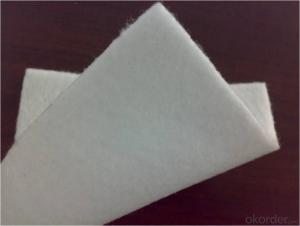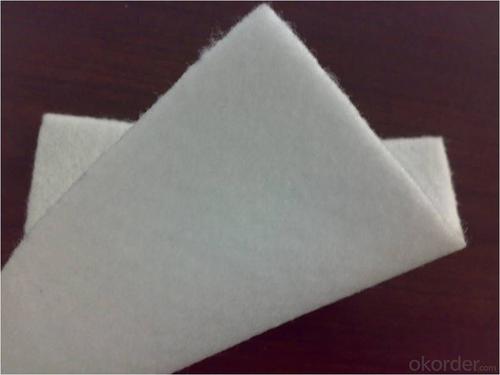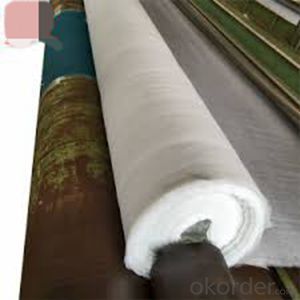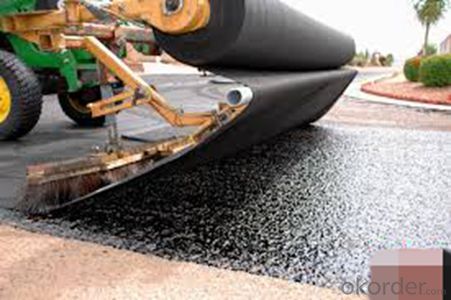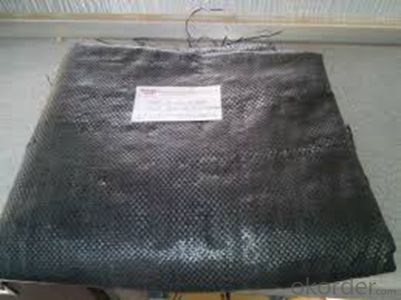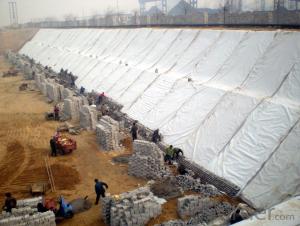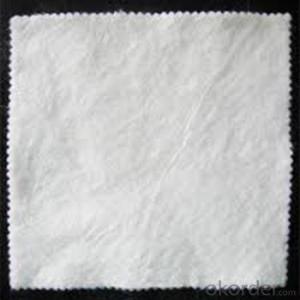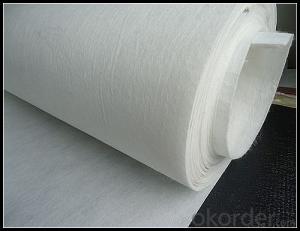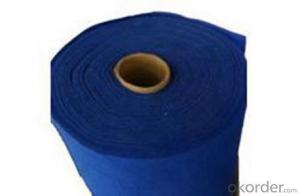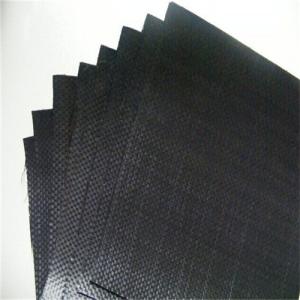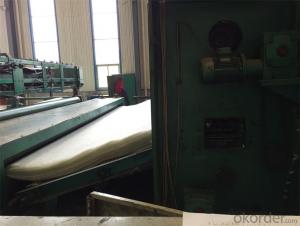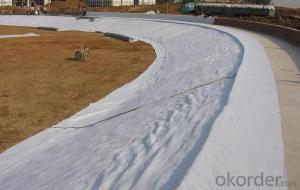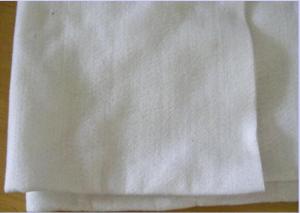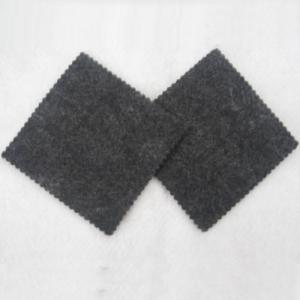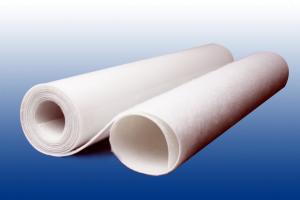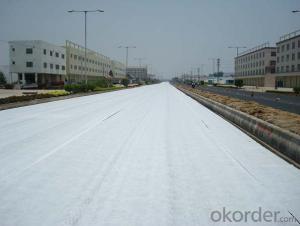500g Coir Nonwoven Geotextile Fabric for Road Construction
- Loading Port:
- China main port
- Payment Terms:
- TT OR LC
- Min Order Qty:
- 1000 m²
- Supply Capability:
- 1000000 m²/month
OKorder Service Pledge
OKorder Financial Service
You Might Also Like
Specification
1. Geotextile Specifications
1) Weight / Mass: 100g/m2-800g/m2
2) Width: Within 6 m (1m-6m)
3) Length: 50m-100m/roll (as request)
4) Material: PP / PET
5) Color: Black , white , grey and other color
6) Certificate: CE/ISO9001 , ISO14001
7) Manufacturing method: nonwoven / woven
8) The Biggest geotextile manufacturer/factory in China for many years
Geotextile Features
1) Staple fibers polypropylene nonwoven geotextile
The geotextile is made of polypropylene staple fibers on cross-laying equipment and needle punched equipment. It owns the advantages of acid and alkali resistance, erosion resistance, aging resistance, large strength, stable size, good filtrability etc.
2) Filament non woven geotextile
Filament geotextile has features as follows: High strength, good capacity of elongation and high biology tolerance, alkali tolerance, acidity tolerance, weather resistance good filtration and fine drainage capacity etc. Also it is of low cost, easy in construction and use effects.
Detailed Images
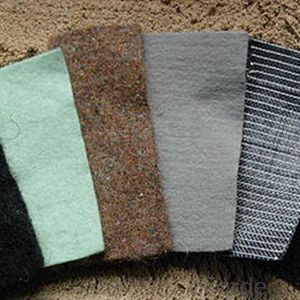
Packaging & Shipping
Packing: PLASTIC FILM INSIDE, AND WOVEN BAG OUTSIDE
Shipping: About 15 days after receipt the deposit
geotextile fabric
permeability,filtration,easy for construction
ISO and CE certificate
Good quality and competitive price
Our Service
Quality assurance
1.On a regular basis or as per your request,we entrust national testing agencies to conduct quality inspections
2. Strictly in accordance with the ISO9001-2008 international quality system standard,we monitor and manage the whole process throughout production,quality testing,and measurement to ensure product quality
3. For quality-related construction delay or substandard construction(except for damage or losses due to customer’s responsibility or irresistible natural disasters),we have refunding,replacement,and repair services.We will respond to customers’ feedbacks on quality issues within 24 hours.
After-sales service
1.In order to provide customers with comprehensive technical support,we will provide technical and other related information upon request in a timely manner.
2.In required,we will appoint specialized technicians to the construction site to give technical trainings to construction people,and offer technical guidance throughout the whole construction process.
3.For damage due to shipment and delivery,after we receive the complaint,we will check the issure through provided pictures and videos.If our responsibility is confirmed,we wil offer free replacement.
4.When the construction is completed,as your request,our technical staff may participate in the final acceptance.
FAQ:
Q: What kind of payments does jenor support?
A: T/T, L/C, Cash are accepted.
Q: Do you charge for the samples?
A: Accordeing to our company policy, the samples are free, we only charge the freight fee. And we will return the freight fee during the next order.
Q: Can you produce according to customers' design?
A: Sure, we are professional manufacturer, OEM and ODM are both welcome.
Q: Do you have other products?
A: Yes, please check the pictures:
- Q: What is the seepage geotextile
- Is the kind of ordinary geotextile
- Q: What is the difference between geotextile and impervious geotextile, geotextile and impervious geotextile?
- What is the difference between geotextile and impervious geotextile, geotextile and impervious geotextile?
- Q: What is the effect of temperature on geotextile performance?
- The effect of temperature on geotextile performance can vary depending on the specific material and application. In general, higher temperatures can cause geotextiles to expand and become less stable, while lower temperatures can make them more rigid and prone to cracking. Extreme temperature fluctuations can also affect the long-term durability and effectiveness of geotextiles. Therefore, it is crucial to consider temperature conditions when selecting and designing geotextile applications to ensure optimal performance and longevity.
- Q: How are geotextiles used in civil engineering?
- Geotextiles are extensively used in civil engineering as a versatile material for various applications. They are commonly employed for soil stabilization, erosion control, drainage management, and reinforcement purposes. Geotextiles can be installed to prevent soil erosion on slopes, act as a separation barrier between different soil layers, provide filtration in drainage systems, and enhance the strength of embankments or roads. Their permeable nature allows for water and gas flow while effectively retaining soil particles, making them an essential component in many civil engineering projects.
- Q: Geotextile 500 grams is what it means
- 500g per square meter of quality, I professional production geotextile geomembrane, wish smooth
- Q: How are geotextiles used in railway construction?
- Geotextiles are used in railway construction to provide stabilization, separation, and filtration functions. They are placed beneath the ballast layer to prevent the mixing of fine particles with the ballast, thus maintaining its stability. Geotextiles also help in the filtration of water, preventing the migration of fines into the drainage system. Additionally, they act as a barrier that separates different layers of the railway structure, reducing the potential for intermixing and improving overall performance and longevity.
- Q: How do geotextiles help with reinforcement of geosynthetic tubes?
- Geotextiles play a crucial role in the reinforcement of geosynthetic tubes by providing added strength and stability to the structure. They act as a barrier between the tube and the surrounding soil, preventing soil particles from infiltrating the tube and causing potential damage. Geotextiles also distribute loads evenly across the tube, reducing the risk of localized stress concentrations. By enhancing the overall stability and load-bearing capacity of the tube, geotextiles significantly contribute to the reinforcement and longevity of geosynthetic tubes in various engineering applications.
- Q: Geomembrane upstream protective layer with what material? The Why can not you use clay?
- The protective layer should be a geotextile because the geotextile is durable than clay.
- Q: What are the different testing methods for geotextiles?
- Some of the different testing methods for geotextiles include tensile strength testing, puncture resistance testing, tear strength testing, burst strength testing, and water flow testing. These tests help evaluate the performance and durability of geotextiles in various applications.
- Q: Can geotextiles be used in erosion control on steep slopes?
- Yes, geotextiles can be used in erosion control on steep slopes. Geotextiles are specially designed fabrics that are used to stabilize soil and prevent erosion. They can be installed on steep slopes to reinforce the soil, reduce water flow, and promote vegetation growth, all of which help to prevent erosion and maintain slope stability.
Send your message to us
500g Coir Nonwoven Geotextile Fabric for Road Construction
- Loading Port:
- China main port
- Payment Terms:
- TT OR LC
- Min Order Qty:
- 1000 m²
- Supply Capability:
- 1000000 m²/month
OKorder Service Pledge
OKorder Financial Service
Similar products
Hot products
Hot Searches
Related keywords
